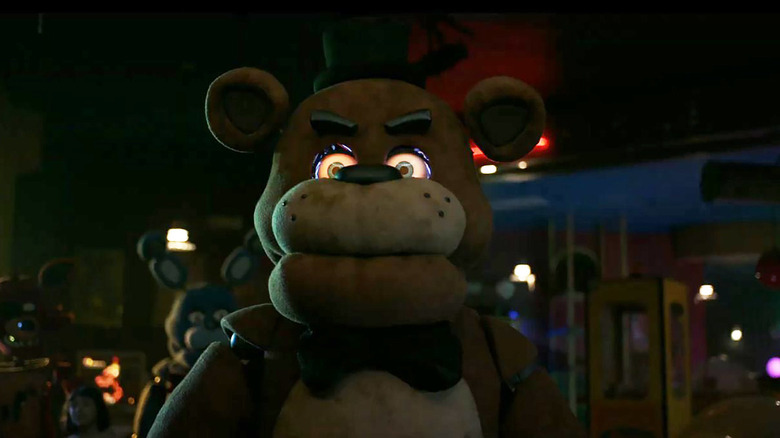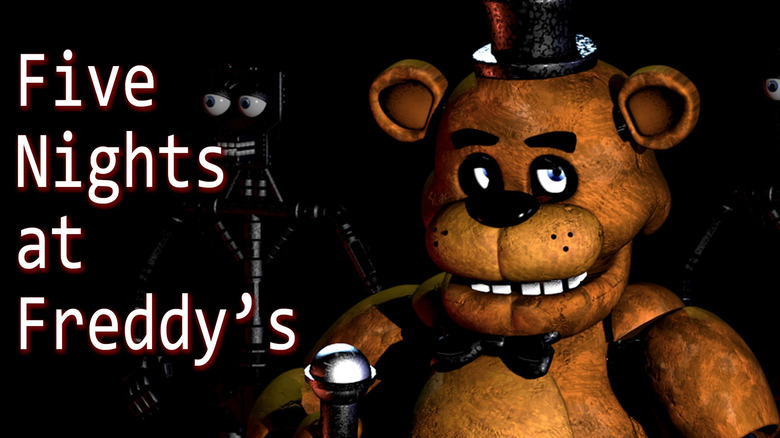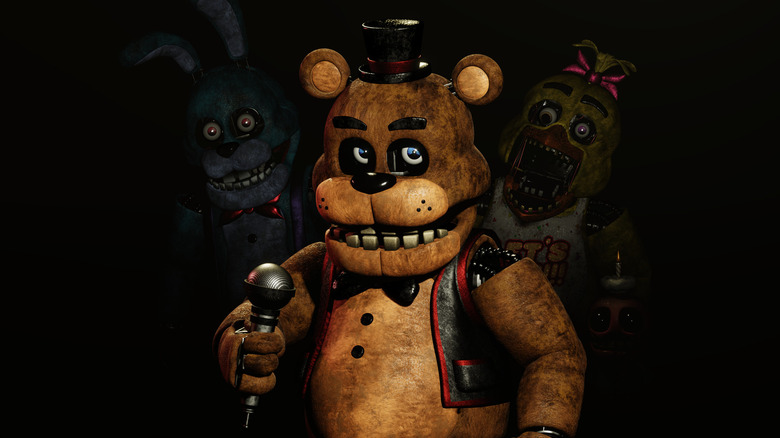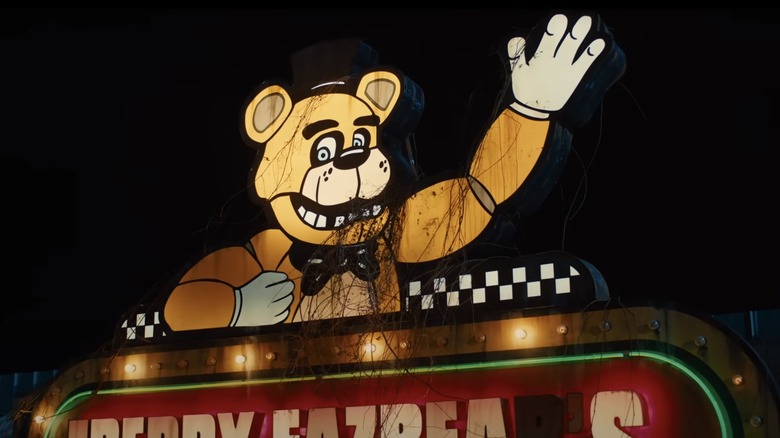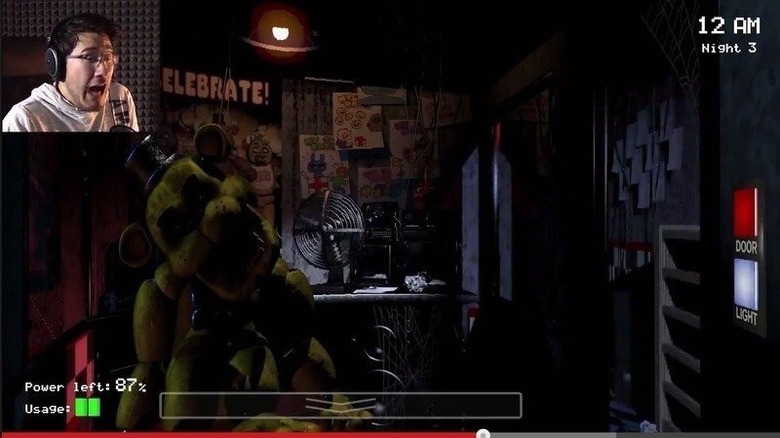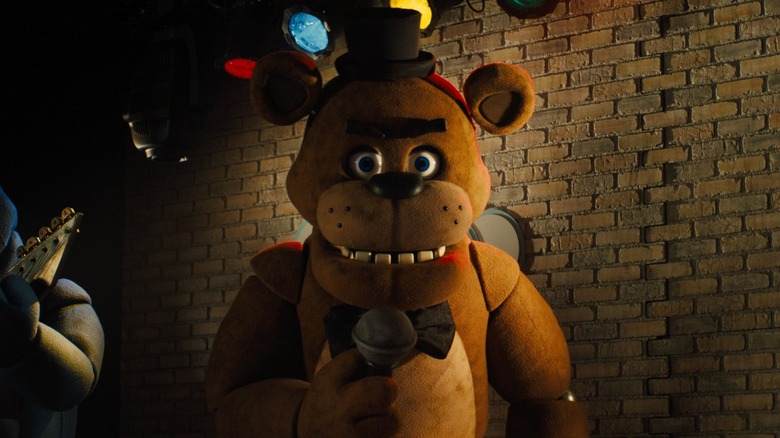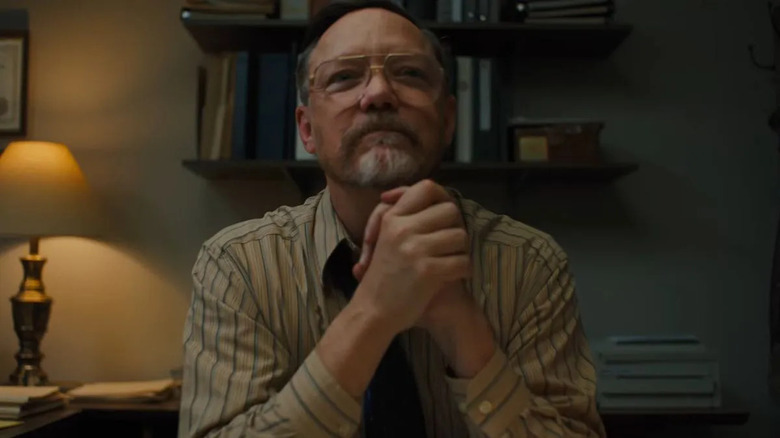Five Nights At Freddy's Explained: The Story Behind One Of This Year's Biggest Horror Movies
The horror mavens over at Blumhouse have finally released what was arguably their most highly-anticipated film of 2023, "Five Nights at Freddy's." An adaptation of Scott Cawthon's absurdly popular video game series, "FNaF" (as the cool kids call it) started out as an indie game on the Desura and later Steam platforms, but become a global phenomenon after footage of popular YouTube Let's Players like Mark "Markiplier" Fischbach and Matthew "MatPat" Patrick getting scared out of their minds became viral sensations. In 2015, a year after the release of the first game, Warner Bros. announced that they were going to adapt the game for the big screen. That, uh, obviously didn't ever come to fruition.
In 2017, things started picking up steam when Blumhouse announced that they were to be the new home of "FNaF," but after a series of delays and director changes, fans started to give up hope that they'd ever see their beloved horror story in the theaters. Fortunately, the wait is over, and "Five Nights at Freddy's" set a new box office record as the top-grossing debut for a Halloween weekend.
But how the hell did "Five Nights at Freddy's" get so popular, and how did Blumhouse turn a video game where you never leave a security room into a feature-length horror film? Allow me to serve as your humble guide to the world of Freddy Fazbear's Pizza, a magical place for kids and grown-ups alike, where fantasy and fun come to life...
And then stuff your dead body into an animatronic puppet.
Who created this nightmare?
"Five Nights at Freddy's" is the brainchild of video game developer Scott Cawthon, who broke into the gaming world making Christian-focused video games like "Pilgrim's Progress" and "The Desolate Hope," the latter of which is essentially anti-abortion propaganda hidden within a video game. In 2013, he put out a family-friendly game called "Chipper & Sons Lumber Co.," which was lambasted by critics, with a few noting that the characters looked like terrifying animatronic creatures you'd see in a place like Chuck E. Cheese or ShowBiz Pizza Place. The negative reviews had a massive impact on Cawthon, but the comments inspired him to pivot toward the horror game sphere, creating "Five Nights at Freddy's."
Understanding the man behind the game is important because Cawthon seems to be at the center of some of the delays for the film adaptation. When Blumhouse announced that veteran director Chris Columbus had left the project in 2021, it was indicated that Cawthon had the final say on the script, and according to Jason Blum, "It's taken longer than I hoped to get the right story."
Cawthon retired from professional game development in 2021, but not before his history of donations was made public, revealing that he made significant financial donations to conservative political candidates, including the disgraced, twice-impeached former president Donald Trump, who was recently found liable for sexual abuse. Before his retirement, Cawthon expanded the "Five Nights at Freddy's" universe to 13 games (including one in space) and 32 books/graphic novels. As of publication, Cawthon is still determining a successor to helm the continuation of the franchise.
What is the game about?
Considering "Five Nights at Freddy's" has hundreds of hours of lore at this point, it may seem overwhelming to try and make sense of what this story is all about. The game started out with humble beginnings, where players were cast as the night watch security guard for Freddy Fazbear's Pizza, only to discover that the animatronics come to life at night, and kill whoever they find. It's almost too perfect in its simplicity, but Scott Cawthon has expanded the story in some pretty wild and gruesome directions.
Freddy Fazbear's Pizza was once a thriving utopia for family fun, but is now a run-down, derelict shadow of its former glory due to a string of tragedies connected to the pizzeria. Fazbear Entertainment was co-founded by a man named William Afton, who is also behind the company Afton Robotics. He's also a serial killer. It was rumored that Afton used the kid-friendly allure of Freddy Fazbear to kidnap and murder five children, shoving their corpses into the animatronic mascots of the pizzeria: Freddy, Bonnie, Chica, and Foxy.
"Five Nights at Freddy's 3" introduced Fazbear's Fright, a horror attraction built to capitalize on the real-life horrors and urban legends that surround the famed chain of pizzerias, while "Five Nights at Freddy's 4" is a prequel game that chronicles the "Bite of '83" tragedy, one of the many horrific "accidents" related to Freddy Fazbear's Pizza. The story focuses on a little boy with a massive fear of animatronics who was forced to attend a birthday party at the pizzeria, where his older brother tried to scare him by putting his head in the FredBear's mouth. Tragically, the terrified tears of the little boy caused a short in the animatronic, triggering the mouth to snap close and kill the child.
This game is dark, and it only gets weirder as the franchise goes on.
What is the movie about?
To be quite frank, the lore of "FNaF' is convoluted at best and confusing at worst, so the screenplay for the film wisely chose to borrow some hard-and-fast fan-accepted canon while inventing new characters and a new backstory for protagonist Mike Schmidt that plays better in the film medium than in a sprawling video game franchise. There are pretty massive differences between the game lore and the film, which director Emma Tammi has described as an "alternate universe." One story is not the "definitive" version of events — they're intentionally different so the fandom can have different pathways to enjoy the series.
The final shooting script was co-written by Scott Cawthon, Seth Cuddeback, and director Emma Tammi, with Cawthon, Chris Lee Hill, and Tyler MacIntyre given a "story by" credit. Cawthon expressed during a Reddit AMA that he was really pleased with the outcome and the decision to go with what he called "the Mike screenplay." This is a reference to the character Mike Schmidt, the protagonist of the first five games, who is being played by Josh Hutcherson. The film's official description of the character follows:
"Riddled with guilt over a tragedy in his past, and now struggling to take care of his younger sister on his own, Mike (Josh Hutcherson) is low on options when he lands a new job to pay the bills; the night security guard at Freddy Fazbear's Pizzeria. Mike is vulnerable with a tough exterior. Though he means well, his obsession with digging for truth may have potentially disastrous consequences."
Based on what we've seen in the first film, Blumhouse definitely pulled from "FNAF" games 1-4, with elements of "Sister Location" and "Security Breach" littered in as Easter eggs. Matthew Lillard was revealed as William Afton while Elizabeth Lail played Vanessa, a character introduced in "Five Nights at Freddy's: Help Wanted," but given new lore that is reflective of different characters from the early "FNaF" games. The fact the film goes beyond the original gameplay and incorporates the complex lore in ways that (somewhat) make sense is nothing short of a miracle.
But how did the fandom get so huge?
As of publication, the trailer for "Five Nights at Freddy's" has amassed over 35 million views on YouTube, and that's not counting the views garnered from an innumerable amount of "trailer reaction videos" or channels that posted the footage to their own feeds. The "FNaF" fandom is huge, passionate, and leans extremely young for a horror franchise. To put it into perspective, the Funko company has released over 80 officially licensed POPs based on the games. When the game first gained popularity, the culture of how people consume media was changing. The streaming wars had begun, Blockbuster announced it was shutting down, and YouTube had become a legitimate channel for entertainment.
Playing "Five Nights at Freddy's" (or watching playthroughs online) was the evolutionary next step of staying up late and seeing a midnight movie on TV. Video game YouTubers often have young fanbases, so they were the first ones to be introduced to the games through their favorite content creators. Additionally, there was a void of new gateway/transitionary horror films and TV shows that could bridge the gap between family-friendly spookfests and legitimate horror releases. Pair that with the fact the animatronic designs were meant to appeal to children within the world of the game, and "FNAF" found the perfect recipe to serve as a generation's introduction to the horror genre.
Freddy Fazbear and the rest of the anthropomorphic mascots shown in "Five Nights at Freddy's" might as well be the new Mount Rushmore of horror icons, and perhaps the Blumhouse film will ultimately add the "legitimacy" to the franchise so many old-school horror fans are fighting like hell to avoid embracing. Slasher villains stalking babysitters don't resonate with young audiences like they used to, and the new face of fear is covered in faux fur.
The critical reception doesn't matter
"Five Nights at Freddy's" is, to put it kindly, breaking the brains of a lot of critics trying to wrap their heads around the success of this film. As of publication, the film boasts a 29 percent critical rating on Rotten Tomatoes, compared to 88 percent from audiences. Critics are certainly not the be-all and end-all of determining a film's success, nor is a film's quality directly correlated to a box office performance, but "Five Nights at Freddy's" is an anomaly success that is worth examining, regardless of how someone personally feels about the film. It's no surprise that Hollywood is an IP-obsessed landscape, with the two highest films of 2023 looking to be "Barbie" and "The Super Mario Bros. Movie," both extremely recognizable properties that have never needed a feature film to be a success. However, both franchises have existed for decades, and came about before the dissolution of the monoculture that came with the advent of social media. As I wrote in a separate article regarding the "Five Nights at Freddy's" fandom:
A lot of people don't realize that an entertainment monoculture no longer exists and that there are massive, passionate fandoms out there that rival Marvel Comics and "Star Wars" that aren't catered to by the status quo. There's the ARMY of K-pop stans for BTS, the Swifties who broke the AMC app, or the fact the most followed person on TikTok is Khaby Lame, who, despite having nearly 162 million followers, is probably unrecognizable to anyone off the app.
The "FNaF" movie was so very clearly made with fans in mind above all else, a rejection of the four quadrant demands of most blockbuster films. It was a huge risk to take, with megaproducer Jason Blum admitting that people made fun of him for pursuing the rights to the film. Well, Blum will laugh his way all the way to the bank, because "FNaF" has only been out for a week and has already landed in the top 26 highest-grossing films of the year. Depending on when you read this article, it's probably sitting even higher.
What does the future of FNaF look like?
While a sequel has not yet been officially announced, Matthew Lillard disclosed back in May of 2023 that his contract included an agreement for a potential three pictures. This does not guarantee a trilogy of films, but based on the overwhelming success of the first film, it seems inevitable. And if/when that happens, Lillard will be back. This also doesn't mean that the franchise is limited to three films, just that Blumhouse and Universal will need to renegotiate with Lillard if they want him to return for additional installments. One of the biggest success stories in all of this is Emma Tammi, who has been said to have been paid $500k to direct the film, but negotiated a backend deal that guarantees a percentage of the film's profits. If Blumhouse is smart, they'll bring her back to direct the sequels, because the fandom has already claimed her as their own and will march into the flames to support her future endeavors.
But while we're on the subject, the biggest winners of it all have been the fans. "Five Nights at Freddy's" has always been a maligned fandom in the greater landscape of video game communities, especially given the rabid obsession found in some of the youngest devotees being seen as "cringe." Given the film's long journey to make it to theaters, expectations were through the roof and while it is impossible to appease to every fan's wants/dreams, the film's success speaks volumes. So to all of the people who came across this article trying to make sense of why your kids are freaking out about a campy movie about animatronic murder mascots or trying to figure out why a lore-heavy PG-13 horror film is one of the highest-grossing films of the year — there's a good chance you're never going to fully understand it. And that's okay.
"Five Nights at Freddy's" will continue to thrive regardless of any one person's opinion.
